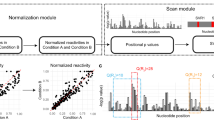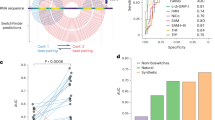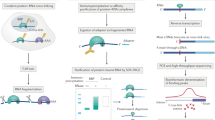Abstract
Decoding post-transcriptional regulatory programs in RNA is a critical step towards the larger goal of developing predictive dynamical models of cellular behaviour. Despite recent efforts1,2,3, the vast landscape of RNA regulatory elements remains largely uncharacterized. A long-standing obstacle is the contribution of local RNA secondary structure to the definition of interaction partners in a variety of regulatory contexts, including—but not limited to—transcript stability3, alternative splicing4 and localization3. There are many documented instances where the presence of a structural regulatory element dictates alternative splicing patterns (for example, human cardiac troponin T) or affects other aspects of RNA biology5. Thus, a full characterization of post-transcriptional regulatory programs requires capturing information provided by both local secondary structures and the underlying sequence3,6. Here we present a computational framework based on context-free grammars3,7 and mutual information2 that systematically explores the immense space of small structural elements and reveals motifs that are significantly informative of genome-wide measurements of RNA behaviour. By applying this framework to genome-wide human mRNA stability data, we reveal eight highly significant elements with substantial structural information, for the strongest of which we show a major role in global mRNA regulation. Through biochemistry, mass spectrometry and in vivo binding studies, we identified human HNRPA2B1 (heterogeneous nuclear ribonucleoprotein A2/B1, also known as HNRNPA2B1) as the key regulator that binds this element and stabilizes a large number of its target genes. We created a global post-transcriptional regulatory map based on the identity of the discovered linear and structural cis-regulatory elements, their regulatory interactions and their target pathways. This approach could also be used to reveal the structural elements that modulate other aspects of RNA behaviour.
This is a preview of subscription content, access via your institution
Access options
Subscribe to this journal
Receive 51 print issues and online access
$199.00 per year
only $3.90 per issue
Buy this article
- Purchase on SpringerLink
- Instant access to full article PDF
Prices may be subject to local taxes which are calculated during checkout




Similar content being viewed by others
References
Dölken, L. et al. High-resolution gene expression profiling for simultaneous kinetic parameter analysis of RNA synthesis and decay. RNA 14, 1959–1972 (2008)
Elemento, O., Slonim, N. & Tavazoie, S. A universal framework for regulatory element discovery across all genomes and data types. Mol. Cell 28, 337–350 (2007)
Rabani, M., Kertesz, M. & Segal, E. Computational prediction of RNA structural motifs involved in posttranscriptional regulatory processes. Proc. Natl Acad. Sci. USA 105, 14885–14890 (2008)
Barash, Y. et al. Deciphering the splicing code. Nature 465, 53–59 (2010)
Wan, Y., Kertesz, M., Spitale, R. C., Segal, E. & Chang, H. Y. Understanding the transcriptome through RNA structure. Nature Rev. Genet. 12, 641–655 (2011)
Pavesi, G., Mauri, G., Stefani, M. & Pesole, G. RNAProfile: an algorithm for finding conserved secondary structure motifs in unaligned RNA sequences. Nucleic Acids Res. 32, 3258–3269 (2004)
Searls, D. B. The language of genes. Nature 420, 211–217 (2002)
Hofacker, I. L., Fekete, M. & Stadler, P. F. Secondary structure prediction for aligned RNA sequences. J. Mol. Biol. 319, 1059–1066 (2002)
Kertesz, M. et al. Genome-wide measurement of RNA secondary structure in yeast. Nature 467, 103–107 (2010)
Goodarzi, H., Elemento, O. & Tavazoie, S. Revealing global regulatory perturbations across human cancers. Mol. Cell 36, 900–911 (2009)
Schwanhäusser, B. et al. Global quantification of mammalian gene expression control. Nature 473, 337–342 (2011)
Cutroneo, K. R. & Ehrlich, H. Silencing or knocking out eukaryotic gene expression by oligodeoxynucleotide decoys. Crit. Rev. Eukaryot. Gene Expr. 16, 23–30 (2006)
Windbichler, N. & Schroeder, R. Isolation of specific RNA-binding proteins using the streptomycin-binding RNA aptamer. Nature Protocols 1, 637–640 (2006)
Biamonti, G., Ruggiu, M., Saccone, S., Della Valle, G. & Riva, S. Two homologous genes, originated by duplication, encode the human hnRNP proteins A2 and A1. Nucleic Acids Res. 22, 1996–2002 (1994)
Wilusz, C. J., Wormington, M. & Peltz, S. W. The cap-to-tail guide to mRNA turnover. Nature Rev. Mol. Cell Biol. 2, 237–246 (2001)
Michlewski, G. & Caceres, J. F. Antagonistic role of hnRNP A1 and KSRP in the regulation of let-7a biogenesis. Nature Struct. Mol. Biol. 17, 1011–1018 (2010)
Ross, D. T. et al. Systematic variation in gene expression patterns in human cancer cell lines. Nature Genet. 24, 227–235 (2000)
Jensen, K. B. & Darnell, R. B. CLIP: crosslinking and immunoprecipitation of in vivo RNA targets of RNA-binding proteins. Methods Mol. Biol. 488, 85–98 (2008)
Keene, J. D., Komisarow, J. M. & Friedersdorf, M. B. RIP-Chip: the isolation and identification of mRNAs, microRNAs and protein components of ribonucleoprotein complexes from cell extracts. Nature Protocols 1, 302–307 (2006)
Licatalosi, D. D. et al. HITS-CLIP yields genome-wide insights into brain alternative RNA processing. Nature 456, 464–469 (2008)
Giannopoulou, E. G. & Elemento, O. An integrated ChIP-seq analysis platform with customizable workflows. BMC Bioinformatics 12, 277–294 (2011)
Beer, M. A. & Tavazoie, S. Predicting gene expression from sequence. Cell 117, 185–198 (2004)
Yang, Y. et al. RNA secondary structure in mutually exclusive splicing. Nature Struct. Mol. Biol. 18, 159–168 (2011)
Greco, T. M., Yu, F., Guise, A. J. & Cristea, I. M. Nuclear import of histone deacetylase 5 by requisite nuclear localization signal phosphorylation. Mol. Cell Proteomics 10, M110.004317 (2011)
Wiśniewski, J. R., Zougman, A., Nagaraj, N. & Mann, M. Universal sample preparation method for proteome analysis. Nature Methods 6, 359–362 (2009)
Chi, S. W., Zang, J. B., Mele, A. & Darnell, R. B. Argonaute HITS-CLIP decodes microRNA-mRNA interaction maps. Nature 460, 479–486 (2009)
Acknowledgements
We thank the members of the Tavazoie laboratory for comments on the project and manuscript. We are also grateful to N. Pencheva, B. Tsui, S. Tavazoie and L. Dölken for their intellectual and technical contributions. L.F. was supported by a Ruth L. Kirschstein National Research Service Award (T32-GM066699). S.T. was supported by grants from NHGRI (2R01HG003219) and the NIH Director's Pioneer Award.
Author information
Authors and Affiliations
Contributions
H.G., H.S.N. and S.T. conceived and designed the study. H.G. and H.S.N. developed TEISER. R.S. contributed to the execution of the study. H.G., H.S.N., T.M.G., P.O., I.M.C. and S.T. designed the experiments. H.G., P.O., L.F. and T.M.G. performed the experiments. H.G., H.S.N. and T.M.G. analysed the results. H.G., H.S.N. and S.T. wrote the paper.
Corresponding author
Ethics declarations
Competing interests
The authors declare no competing financial interests.
Supplementary information
Supplementary Information
This file contains Supplementary Figures 1-15, Supplementary Tables 1-2 and additional references. (PDF 2659 kb)
Rights and permissions
About this article
Cite this article
Goodarzi, H., Najafabadi, H., Oikonomou, P. et al. Systematic discovery of structural elements governing stability of mammalian messenger RNAs. Nature 485, 264–268 (2012). https://doi.org/10.1038/nature11013
Received:
Accepted:
Published:
Issue Date:
DOI: https://doi.org/10.1038/nature11013



